Seal meat

Seal meat is the flesh, including the blubber and organs, of seals used as food for humans or other animals. It is prepared in numerous ways, often being hung and dried before consumption. Historically, it has been eaten in many parts of the world.
Practice of seal consumption by humans continues today in Japan, Canada and Norway.[1]
Nutritional value
[edit]| Nutritional value per 100 g (3.5 oz) | |||||||||||||||||||||||||||||
|---|---|---|---|---|---|---|---|---|---|---|---|---|---|---|---|---|---|---|---|---|---|---|---|---|---|---|---|---|---|
3.2g | |||||||||||||||||||||||||||||
| Saturated | .820g | ||||||||||||||||||||||||||||
| Monounsaturated | 1.720g | ||||||||||||||||||||||||||||
| Polyunsaturated | 0.060g | ||||||||||||||||||||||||||||
28.4 g | |||||||||||||||||||||||||||||
| |||||||||||||||||||||||||||||
| †Percentages estimated using US recommendations for adults,[2] except for potassium, which is estimated based on expert recommendation from the National Academies.[3] | |||||||||||||||||||||||||||||
Seal blubber and meat was studied to help understand the nutritional composition. Two species were evaluated by the Department of Biology of the University of Bergen and the National Institute of Nutrition and Seafood Research. The species were the hooded seal (Cystophora cristata) and harp seal (Phagophilus groenlandicus). The specimens used in the study were taken from Greenland's West Ice.
Seal meat in general is lean, containing less than 2% fat. This fat is mostly MUFAs, long- and very long chain omega-3 PUFAs. Also, the meat is high in protein and has an amino acid composition that is well balanced.

The study showed significant differences in nutritional composition from one seal to another. This may have been due to the highly varied age and size of the seals tested. In general, both the meat and blubber can be considered to be high quality food in terms of bioactive components and nutrients. On average, a woman's recommended daily intake of vitamin B12 and iron can be met with only 40 grams of seal meat.
A significant difference between species was found in the eicosapentaenoic acid (EPA) content of both the meat and blubber. Harp seal blubber contained 9.2% while the muscle tissue contained only 3%.
High levels of trace elements were found. In particular, hooded seal muscle meat contained 379 μg/g of iron and harp seal muscle meat contained 30 μg/g of zinc.[5]
High levels of mercury have been found in the blubber of seals of the Canadian arctic.[6]
See also
[edit]- Country food
- Inuit cuisine
- Chukchi cuisine
- Flipper pie
- Marine mammals as food
- Wildlife trade
 Food portal
Food portal
References
[edit]- ^ "These Countries Consider Whale and Seal Hunting Essential Activities During the Coronavirus Pandemic".
- ^ United States Food and Drug Administration (2024). "Daily Value on the Nutrition and Supplement Facts Labels". FDA. Archived from the original on 2024-03-27. Retrieved 2024-03-28.
- ^ National Academies of Sciences, Engineering, and Medicine; Health and Medicine Division; Food and Nutrition Board; Committee to Review the Dietary Reference Intakes for Sodium and Potassium (2019). "Chapter 4: Potassium: Dietary Reference Intakes for Adequacy". In Oria, Maria; Harrison, Meghan; Stallings, Virginia A. (eds.). Dietary Reference Intakes for Sodium and Potassium. The National Academies Collection: Reports funded by National Institutes of Health. Washington, DC: National Academies Press (US). pp. 120–121. doi:10.17226/25353. ISBN 978-0-309-48834-1. PMID 30844154. Retrieved 2024-12-05.
- ^ "Seal, meat (Alaska Native), ringed". Retrieved 26 September 2014.
- ^ "Nutritional composition of blubber and meat of hooded seal (Cystophora cristata) and harp seal (Phagophilus groenfandicus) from Greenland". Retrieved 26 September 2014.
- ^ Braune, B (16 August 2005). "Persistent organic pollutants and mercury in marine biota of the Canadian Arctic: An overview of spatial and temporal trends" (PDF). Science of the Total Environment. 351–352: 32. Bibcode:2005ScTEn.351....4B. doi:10.1016/j.scitotenv.2004.10.034. PMID 16109439. Archived from the original (PDF) on 10 August 2017. Retrieved 26 February 2018.


